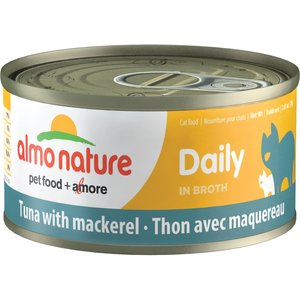Ingredients
Tuna
Tuna is a common ingredient in cat food and is a good source of protein and omega-3 fatty acids. It is generally considered a healthy ingredient for cats, but some cats may be allergic to it.
Water Sufficient For Cooking
Water is added to the cat food to provide moisture and help with the cooking process. It is not an ingredient that provides nutritional value, but it is essential for hydration.
Mackerel
Mackerel is a fish that is often used in cat food. It is a good source of protein and omega-3 fatty acids. It is generally considered a healthy ingredient for cats, but some cats may be allergic to it.
Guaranteed Analysis
| Crude Protein | 17.0% min |
| Crude Fat | 1.0% min |
| Crude Fiber | 0.5% max |
| Moisture | 78.5% max |
| Ash | 3.0% max |
Crude Protein
Crude protein is an essential nutrient for cats as it helps in building and repairing tissues, promoting healthy growth, and supporting a strong immune system. With a minimum value of 17.0%, the crude protein content in Almo Nature Daily Tuna with Mackerel in Broth Grain-Free Canned Cat Food is considered good for cats.
Crude Fat
Crude fat is an important source of energy for cats and aids in the absorption of fat-soluble vitamins. With a minimum value of 1.0%, the crude fat content in Almo Nature Daily Tuna with Mackerel in Broth Grain-Free Canned Cat Food is relatively low. While cats require a moderate amount of fat in their diet, excessively high fat content can lead to obesity and other health issues. Therefore, the provided value can be considered suitable for cats.
Crude Fiber
Crude fiber is beneficial for a cat's digestive health as it aids in proper bowel movements and prevents constipation. With a maximum value of 0.5%, the crude fiber content in Almo Nature Daily Tuna with Mackerel in Broth Grain-Free Canned Cat Food is relatively low. While some amount of fiber is necessary, excessive fiber content may lead to digestive disturbances. Hence, the given value can be considered appropriate for cats.
Moisture
Moisture content is crucial for maintaining a cat's hydration and overall well-being. With a maximum value of 78.5%, Almo Nature Daily Tuna with Mackerel in Broth Grain-Free Canned Cat Food provides a high moisture content, which is beneficial for cats. Adequate hydration is essential for proper kidney function and urinary tract health in cats.
Ash
Ash content represents the mineral content in cat food. With a maximum value of 3.0%, the ash content in Almo Nature Daily Tuna with Mackerel in Broth Grain-Free Canned Cat Food is within an acceptable range. While some minerals are necessary for a cat's health, excessive ash content may indicate the presence of low-quality ingredients. Therefore, the provided value can be considered suitable for cats.
Pros and Cons
Pros
- High protein content
- Grain-free
- Includes tuna and mackerel
Cons
- Unappealing smell to some cats
- Some cats may not like the taste
- Can be difficult to open
Evaluation
Pet Food AI has assigned 3 stars to Almo Nature Daily Tuna with Mackerel in Broth Grain-Free Canned Cat Food.
![]()
![]()
![]()
This food, Almo Nature Daily Tuna with Mackerel in Broth Grain-Free Canned Cat Food, has a high protein content and is grain-free, making it a suitable option for cats. However, the strong smell may deter some cats from eating it, and the taste may not be appealing to all cats. Additionally, the can can be difficult to open. Overall, this food is recommended for cats who enjoy tuna and mackerel flavors and can tolerate the smell.
Frequently Asked Questions
Is this food healthy for cats?
Yes, this food is healthy for cats as it contains a high protein content and is grain-free. However, it should be served as a supplement to a complete and balanced diet.
Can this food cause allergies?
This food does not include common allergens such as wheat, soy, or dairy. However, individual cats may have specific allergies, so it is recommended to monitor your cat's reaction to the food.
Should this food be combined with others?
It is recommended to combine this food with a complete and balanced diet to ensure all nutritional needs are met. The proportions of the combination should be determined based on the specific dietary requirements of the cat.
